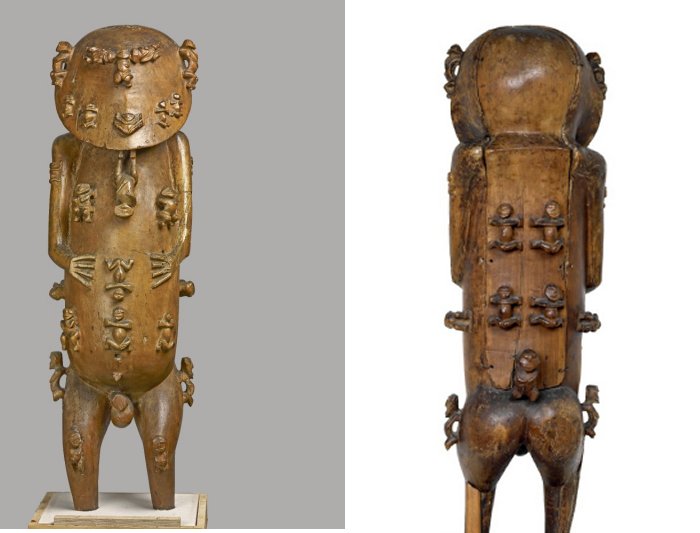Pacific God A’a: Fascinating Polynesian Sculpture Designed To Carry A Human Skull And Bones
A. Sutherland - AncientPages.com - A sculpture of the Pacific God A'a is a fascinating piece of art. The figure of A'a is probably the most famous Polynesian sculpture in the world. It is designed to carry a human skull and bones.
God figure (made of wood) known as A’a, carved in an anthropomorphic form with 30 small anthropomorphic figures over the surface of the body and making up the facial features. A lidded cavity in back. Image credit: The British Museum
The enigmatic sculpture of this deity has influenced poets and artists worldwide, including, first of all, people in Polynesia.
Henry Moore (1898 – 1986), an English sculptor and artist, and the famous Pablo Picasso both had their casts made of the figure; poet William Empson wrote a poem about A'a and the Museum, and it continues to inspire people today.
A'a was created to contain the divine – the figure would originally have been used to hold the skull and bones of an important ancestor.
A'a was an essential and sacred figure in Rurutu and was one of the most highly prized pieces collected by the London Missionary Society (LMS).
In 1821, islanders on the Polynesian island of Rurutu gave a group of British evangelical missionaries a figure of a deity known as A'a as a symbol of their conversion to Christianity.
Thirty unique small figures sprang from its body, representing fertility and the god's ability to create life.
Today, it is one of the most famous, intriguing, and unique objects in the British Museum.
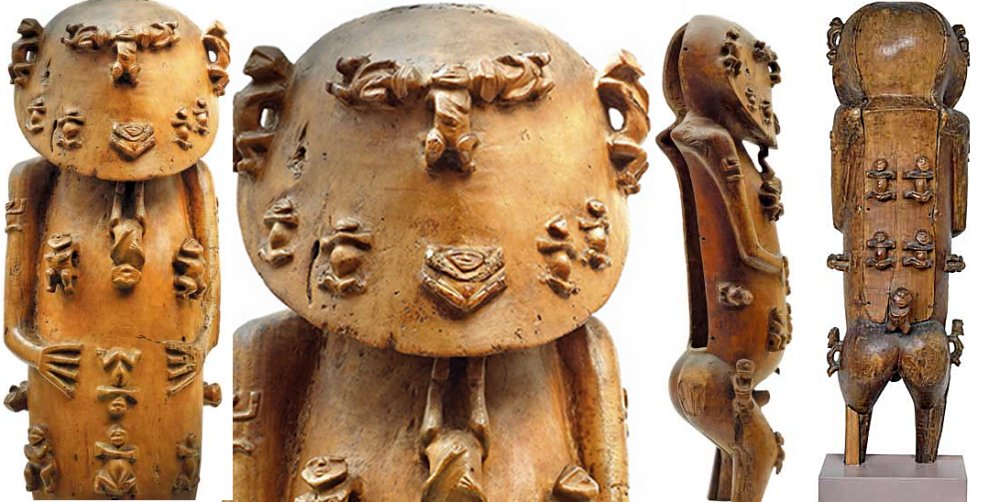 Researchers realized that A’a is made of sandalwood. Wood samples showed it was made much earlier than previously thought – possibly as early as 1505. Its cavity is designed for a human skull and long bones to fit perfectly within, wrapped in sacred materials such as the barkcloth, feathers, and human hair which were also discovered inside. Credits: British Museum
Researchers realized that A’a is made of sandalwood. Wood samples showed it was made much earlier than previously thought – possibly as early as 1505. Its cavity is designed for a human skull and long bones to fit perfectly within, wrapped in sacred materials such as the barkcloth, feathers, and human hair which were also discovered inside. Credits: British Museum
The style of Rurutu, to the north of the group, uses the star design and chevrons but is otherwise less ornate. Some objects were traded to other islands, the most common being fly-whisk handles, which were exported to Tahiti.
Each handle was topped by a pair of figures placed back to back. The shaft below was incised with chevrons or, more characteristically, consisted of a vertical series of spools. Slender spearheads were carved with miniature stylized pigs, resembling phalli.
Carved wooden shafts partly covered with woven sennit were sacred objects on Rurutu, as elsewhere in Polynesia.
Perhaps the only surviving example of figure sculpture from Rurutu is one of the most impressive Polynesian sculptures: an image of A'a creating men and other gods. The primary figure, in Society Islands style, has 30 small stylized figures arranged symmetrically on its torso, limbs, and face, 10 being placed as the facial features.
The figure has a hollow back and, when found, contained 24 small figures (now lost).
Recently, researchers realized that A'a is made of sandalwood. Wood samples showed it was made much earlier than previously thought – possibly as early as 1505.
Its cavity is designed for a human skull and long bones to fit perfectly within. It was also discovered inside, wrapped in sacred materials such as barkcloth, feathers, and human hair. One tiny red feather lodged in a splinter had gone unnoticed for 200 years.
Written by – A. Sutherland - AncientPages.com Senior Staff Writer
Updated on Apr 26, 2024
Copyright © AncientPages.com All rights reserved. This material may not be published, broadcast, rewritten or redistributed in whole or part without the express written permission of AncientPages.com
Expand for referencesReferences:
Gell A. Art and Agency: An Anthropological Theory
Grey George. Polynesian Mythology And Ancient Traditional History Of The New Zealanders
More From Ancient Pages
-
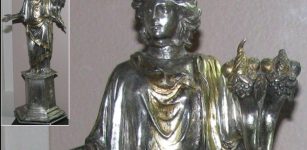 Abundantia: Roman Goddess Who Was Shaking Her Gifts From Cornucopia – ‘Horn Of Plenty’
Featured Stories | Nov 4, 2019
Abundantia: Roman Goddess Who Was Shaking Her Gifts From Cornucopia – ‘Horn Of Plenty’
Featured Stories | Nov 4, 2019 -
 Devil’s Advocate – Ancient Phrase Traced To The Roman Catholic Church
Ancient History Facts | Nov 19, 2018
Devil’s Advocate – Ancient Phrase Traced To The Roman Catholic Church
Ancient History Facts | Nov 19, 2018 -
 Gravitational Waves Shed Light On The Mysterious Antikythera Mechanism
News | Jun 29, 2024
Gravitational Waves Shed Light On The Mysterious Antikythera Mechanism
News | Jun 29, 2024 -
 Unexplained Phenomenon Around Yellowstone Puzzles Scientists
Featured Stories | Nov 12, 2018
Unexplained Phenomenon Around Yellowstone Puzzles Scientists
Featured Stories | Nov 12, 2018 -
 Matches Were Invented In Ancient China
Ancient History Facts | Mar 7, 2019
Matches Were Invented In Ancient China
Ancient History Facts | Mar 7, 2019 -
 Unusual Ancient Spider Pipes Of Tennessee – Were They Used By Shamans To Enter The Spirit World?
Ancient Mysteries | Feb 18, 2018
Unusual Ancient Spider Pipes Of Tennessee – Were They Used By Shamans To Enter The Spirit World?
Ancient Mysteries | Feb 18, 2018 -
 Mysterious Ancient Dark Object Hidden In The Colorado Mountains – What Happened To It?
Featured Stories | Jun 17, 2024
Mysterious Ancient Dark Object Hidden In The Colorado Mountains – What Happened To It?
Featured Stories | Jun 17, 2024 -
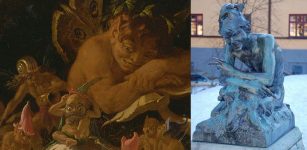 Playful Puck (Robin Goodfellow) – Master Of Harmless Mischief And Shakespeare’s Visit To The Magic Valley
Myths & Legends | Jun 22, 2024
Playful Puck (Robin Goodfellow) – Master Of Harmless Mischief And Shakespeare’s Visit To The Magic Valley
Myths & Legends | Jun 22, 2024 -
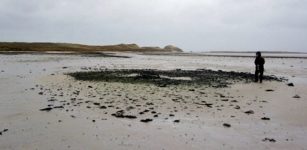 One Of The Biggest Bronze Age Settlements On Orkney – Discovered
Archaeology | Dec 11, 2015
One Of The Biggest Bronze Age Settlements On Orkney – Discovered
Archaeology | Dec 11, 2015 -
 On This Day In History: Moscow Armistice Signed Between Finland And Soviet Union – On Sep 19, 1944
News | Sep 19, 2016
On This Day In History: Moscow Armistice Signed Between Finland And Soviet Union – On Sep 19, 1944
News | Sep 19, 2016 -
 Emperor Caligula’s Ancient Garden Found Under Piazza Pia In Rome, Italy
Archaeology | Jul 26, 2024
Emperor Caligula’s Ancient Garden Found Under Piazza Pia In Rome, Italy
Archaeology | Jul 26, 2024 -
 Underground Hellenistic Necropolis With Tombs With Frescoes, Reliefs Unearthed In Naples, Italy
Archaeology | May 13, 2023
Underground Hellenistic Necropolis With Tombs With Frescoes, Reliefs Unearthed In Naples, Italy
Archaeology | May 13, 2023 -
 Ancient Temple At Taposiris Magna In Alexandria, Egypt, Reveals Some Of Its Secrets
Archaeology | Dec 18, 2024
Ancient Temple At Taposiris Magna In Alexandria, Egypt, Reveals Some Of Its Secrets
Archaeology | Dec 18, 2024 -
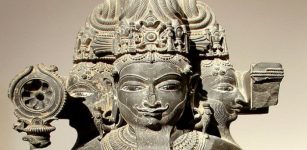 Brahma: First God In Hindu Trimurti, Creator Of The World And All Creatures
Featured Stories | Apr 17, 2019
Brahma: First God In Hindu Trimurti, Creator Of The World And All Creatures
Featured Stories | Apr 17, 2019 -
 Incredibly Rare 3,500-Year-Old Wooden Spade Found In English Trench
Artifacts | Oct 30, 2024
Incredibly Rare 3,500-Year-Old Wooden Spade Found In English Trench
Artifacts | Oct 30, 2024 -
 Underground Catacombs Of Alexandria: Ancient Time Capsule Which Remained Hidden For Almost Two Millennia
Featured Stories | Sep 20, 2016
Underground Catacombs Of Alexandria: Ancient Time Capsule Which Remained Hidden For Almost Two Millennia
Featured Stories | Sep 20, 2016 -
 Unknown Holographic Technology Hidden In Old Monastery Reveals A Surprising Secret
Ancient Mysteries | Dec 7, 2018
Unknown Holographic Technology Hidden In Old Monastery Reveals A Surprising Secret
Ancient Mysteries | Dec 7, 2018 -
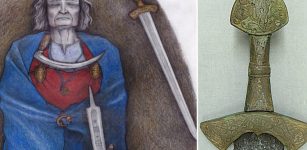 Suontaka Weapon Grave: New Light On Strong Female Leaders And Warriors Of Late Iron Age Finland
Archaeology | Jul 29, 2021
Suontaka Weapon Grave: New Light On Strong Female Leaders And Warriors Of Late Iron Age Finland
Archaeology | Jul 29, 2021 -
 Is There An Ancient Secret Connection Between The Statue Of Liberty And The Anunnaki Goddess Inanna?
Featured Stories | Sep 28, 2018
Is There An Ancient Secret Connection Between The Statue Of Liberty And The Anunnaki Goddess Inanna?
Featured Stories | Sep 28, 2018 -
 Melipona Beecheii – Sacred Ancient Maya Beekeeping Site Discovered In Quintana Roo, Mexico
Archaeology | May 28, 2024
Melipona Beecheii – Sacred Ancient Maya Beekeeping Site Discovered In Quintana Roo, Mexico
Archaeology | May 28, 2024

